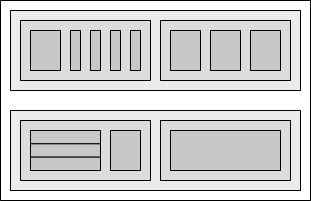| [ << Music engraving ] | [Top][Contents][Index] | [ Literature list >> ] |
| [ < Building software ] | [ Up : Building software ] | [ What symbols to engrave? > ] |
Music representation
Ideally, the input format for any high-level formatting system is an abstract description of the content. In this case, that would be the music itself. This poses a formidable problem: how can we define what music really is? Instead of trying to find an answer, we have reversed the question. We write a program capable of producing sheet music, and adjust the format to be as lean as possible. When the format can no longer be trimmed down, by definition we are left with content itself. Our program serves as a formal definition of a music document.
The syntax is also the user-interface for LilyPond, hence it is easy to type:
{
c'4 d'8
}
to create a quarter note on middle C (C1) and an eighth note on the D above middle C (D1).
On a microscopic scale, such syntax is easy to use. On a larger scale, syntax also needs structure. How else can you enter complex pieces like symphonies and operas? The structure is formed by the concept of music expressions: by combining small fragments of music into larger ones, more complex music can be expressed. For example
f'4![[image of music]](../d7/lily-c5077621.png)
Simultaneous notes can be constructed by enclosing them with
<< and >>:
<<c4 d4 e4>>
This expression is put in sequence by enclosing it in curly braces
{ … }:
{ f4 <<c4 d4 e4>> }
The above is also an expression, and so it may be combined again
with another simultaneous expression (a half note) using
<<, \\, and >>:
<< g2 \\ { f4 <<c4 d4 e4>> } >>
Such recursive structures can be specified neatly and formally in a context-free grammar. The parsing code is also generated from this grammar. In other words, the syntax of LilyPond is clearly and unambiguously defined.
User-interfaces and syntax are what people see and deal with most. They are partly a matter of taste, and also the subject of much discussion. Although discussions on taste do have their merit, they are not very productive. In the larger picture of LilyPond, the importance of input syntax is small: inventing neat syntax is easy, while writing decent formatting code is much harder. This is also illustrated by the line-counts for the respective components: parsing and representation take up less than 10% of the source code.
When designing the structures used in LilyPond, we made some different decisions than are apparent in other software. Consider the hierarchical nature of music notation:
In this case, there are pitches grouped into chords that belong to measures, which belong to staves. This resembles a tidy structure of nested boxes:
Unfortunately, the structure is tidy because it is based on some excessively restrictive assumptions. This becomes apparent if we consider a more complicated musical example:
In this example, staves start and stop at will, voices jump around between staves, and the staves have different time signatures. Many software packages would struggle with reproducing this example because they are built on the nested box structure. With LilyPond, on the other hand, we have tried to keep the input format and the structure as flexible as possible.
| [ << Music engraving ] | [Top][Contents][Index] | [ Literature list >> ] |
| [ < Building software ] | [ Up : Building software ] | [ What symbols to engrave? > ] |
![[image of music]](../07/lily-861277bc.png)
![[image of music]](../b9/lily-aca2fd36.png)
![[image of music]](../90/lily-ca28e028.png)
![[image of music]](../9f/lily-7541c0be.png)
![[image of music]](../25/lily-ae398361.png)

![[image of music]](../a1/lily-ab300897.png)